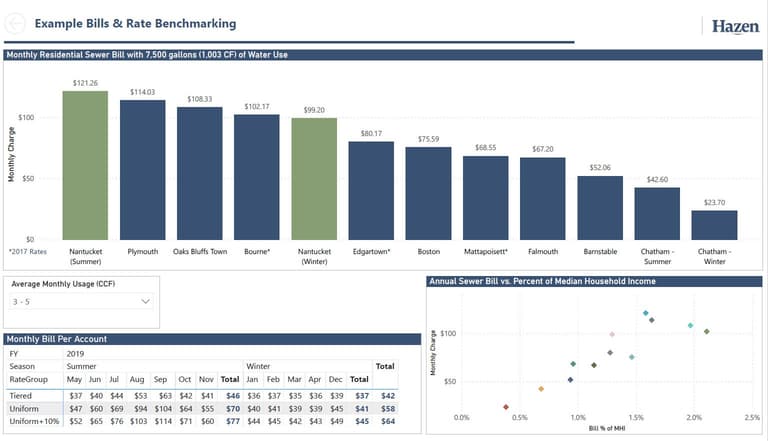Maintaining Financial Resiliency During and After the COVID-19 Pandemic

Business shutdowns and stay-at-home orders resulting from the COVID-19 pandemic have significantly contracted America’s economy and quickly reshaped the demand for potable water and wastewater treatment at many utilities. Utility data indicates a dramatic decrease in water consumption by commercial, government/institutional, and industrial customers. Concurrently, residential demand has surged in many communities. Domestic wastewater generation patterns have followed a similar pattern.
The magnitude of financial impacts to individual utilities will be driven by customer demographics, local economic conditions, pre-COVID-19 financial strength, and the duration and extent of the regional lockdown. Changes in the demand for water and wastewater services could have far reaching impacts on a utility’s creditworthiness, its rate affordability, and its capacity to execute capital investment plans to meet level of service objectives, including robust asset management.
The pandemic has heightened the need for utilities to identify potential vulnerabilities to their long-term financial health and develop strategies to manage those risks. By taking a phased approach in addressing financial risks, utilities can improve resiliency, weather the COVID-19 pandemic, and cope with other unforeseen disruptive events that may occur in the future.
Related Topics:


Case Study
The Town of Nantucket in Massachusetts is a relatively affluent community and well-known tourist destination. It also has a very substantial 10-Year CIP estimated to cost $231.8 million. Gauging the magnitude of impacts of the CIP on the Town’s finances, including the impacts on sewer rates and property taxes (the latter of which is used to fund much of the capital expenditures) was rendered difficult because the Town did not have a robust planning tool. Nantucket tasked Hazen to perform a series of financial evaluations including a financial capability assessment, development of a dynamic rate model, and a financial investment timing model to prioritize and optimize the proposed investments.
The series of financial evaluations identified—among other issues—that under the current rates the Town would generate insufficient revenue in the Capital Improvement Reserve to cover debt service by 2024. Accordingly, the Town has conducted a detailed reassessment of its rates, its rate structure, and other financial management practices to ensure that sewer program costs are fully funded, debt service payments are covered, all costs are borne in an equitable manner, and that a robust planning process is put in place to ensure the financial health and resiliency of the Town’s Utility Department. These initiatives will not only ensure that the Town will meet all its financial obligations but will have built a planning process to ensure its financial health even under unpredictable, adverse economic conditions.

Moving Forward
Across the country, utilities implemented emergency and business continuity plans at the onset of the COVID-19 pandemic to ensure seamless operation of their facilities and protection of their workers and the communities they serve by purchasing PPE, rotating operations workers, and performing business functions remotely where feasible.
While some initiatives were implemented immediately, others can have progressively longer time horizons. Because the timing of businesses reopening is uncertain and will vary by location, progress will not be uniform or linear, especially if there are continued cycles of “reopening” and “closing” the economy. As the recovery ultimately begins to take hold, utilities should gain a greater insight into what the “new normal” will look like.
Although the financial impacts to water utilities have been highly variable and less severe than first expected, many uncertainties remain. Revenues may continue to be lower than normal; rate structures might become misaligned, unemployment rates might remain elevated, and low-income households, who have been disproportionately impacted by the pandemic could face increasing affordability issues. As future spikes and further spread of COVID-19 are possible, and as the benefits of the Federal financial stimulus packages wane over time, additional water and sewer bill defaults are possible.
Frequent, rapid changes in the status of (and response to) the pandemic makes predictions of long-term financial impacts more difficult. Changes in business practices and consumer preferences and behavior may have lasting effects that could affect future expectations and long-term outlooks. Utilities should consider potential longer term impacts of the pandemic on regulatory compliance, bond ratings, CIP planning, and the execution of mission critical projects with longer horizons. Utilities with AAA Bond ratings typically have more than a year of operational reserve while a less financially secure utility might fall short of even the minimum target of 90 days. Early indications are that utilities are carrying on with ongoing projects but are delaying new project startups to maintain cash reserves in a time of tremendous uncertainty.
Accordingly, it is important that utilities reassess all aspects of their financial management and identify strategies and policies that will enhance their financial resiliency to disruptive events such as the COVID-19 pandemic while considering the chance of future events with similar or even greater disruptive power. For example, it would be prudent to reassess whether consumption behavior has changed sufficiently to reassess the current rate structure and future water supply plans. Scenario planning can also be used as a “stress test” to help utilities identify where they are most vulnerable, so plans can be developed to manage and mitigate impacts should the pandemic continue or be confounded by other macroeconomic conditions.










